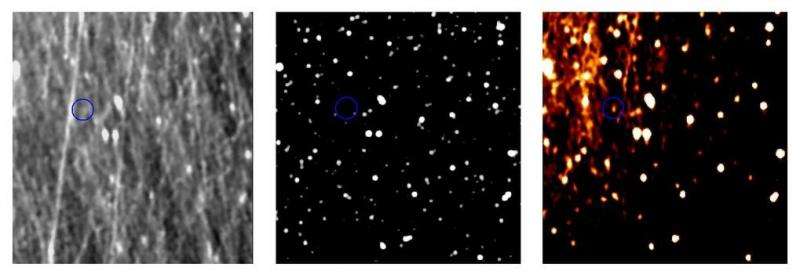Rosetta takes a glance at Pluto

On Sunday, 12 July 2015, OSIRIS, the scientific imaging system on board ESA's spacecraft Rosetta, took a glance towards the rim of our Solar System. Instead of studying comet 67P/Churyumov-Gerasimenko as in the past 15 months, the instrument took a peek at Pluto. NASA's space probe New Horizons passes by the distant dwarf planet today. An exposure time of more than three hours and sophisticated image processing were necessary to detect Pluto in the OSIRIS images taken from a distance of more than five billion kilometers. Pluto is thus the most distant body within the Solar System that Rosetta has ever looked at.
Admittedly, from today's distance of only 12500 kilometers, New Horizons had a much better view of Pluto. However, last Sunday OSIRIS also succeeded in imaging the dwarf planet – from a distance of more than five billion kilometers. Rosetta's scientific imaging system thus joins the ranks of ground-based telescopes and space instruments supporting the New Horizons mission with additional observations.
Being able to discern the 2370 kilometer sized body in OSIRIS images comes close to a small miracle. "After all, OSIRIS is not a telescope, but a camera system designed to study Rosetta's comet from up close", explains OSIRIS Principal Investigator Holger Sierks from the Max Planck Institute for Solar System Research (MPS) in Germany. 20 images, each exposed for ten minutes, had to be stacked and carefully processed.
"Apart from the huge distance there was another difficulty", says OSIRIS team member Dennis Bodewits from the University of Maryland who worked on the images. "Comet 67P and Rosetta are by now surrounded by a dense atmosphere of gas and dust. It's like watching Pluto through a blizzard."
The Pluto images once again prove OSIRIS to have a wandering eye. During its ten year approach of comet 67P the instrument not only took close looks at the planets Earth and Mars and the asteroids Steins and Lutetia during flybys, but also imaged the more distant comet 9P/Tempel 1, asteroid P/2010 A2, and Saturn. "As in the case of Pluto, in comparison to observations from Earth such images often offer a unique and instructive viewing perspective", says Sierks.
Another highlight was the first images of Rosetta's comet itself taken three years before arrival from a distance of 163 million kilometers. "The new Pluto images now surpass even that achievement", says Sierks.
The entire Rosetta team kept its fingers crossed for today's flyby and sends its best wishes for the ongoing mission.
Rosetta is an ESA mission with contributions from its member states and NASA. Rosetta's Philae lander is provided by a consortium led by DLR, MPS, CNES and ASI. Rosetta is the first mission in history to rendezvous with a comet, escort it as it orbits the Sun, and deploy a lander to its surface.
Provided by Max Planck Society





















